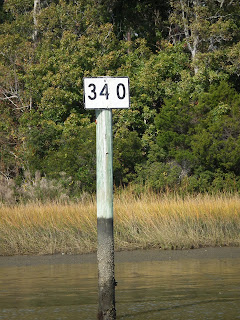With a prediction of only 30% chance of rain we decided to push on and get to South Carolina. Well we were in the zone and got rain. Not like a Michigan fall rain, this was straight down, no wind, just a little cool and a lot wet. Starting at ICW mile 315 we made our way down the ditch. Tom wanted to try coiling our dock lines a different way so I took the helm, watching the depth and pelicans, other boats, ( must be a holiday lots of boats out here, little boats, fast boats, lets make a wake and rock the sail boat, boats.) I was watching a pelican make a circle then take a dive, it is really funny how the dive to catch a fish, and it bounced out. Apparently it didn't take into account low tide. After a minute of regrouping it flew off, I think I saw a pink blush of embarrassment in its white face feathers.
Lockwoods Folly inlet gave me the first tugs at the wheel the tide rips were very strong. Tom talked me through, and we motored on. Mile 340.8 we crossed into South Carolina - not much to tell the difference from one to the other than the line on the chart, but it stopped raining for a while, sun came out and we were happy.
At Mile 347.3 we came to the Little River Swing Bridge. The tender there is a hoot, we listened to his conversations with others coming down the ditch and chuckled. I will post the second half of the trip -- sorry I take so many pictures that I want to share with you.




















No comments:
Post a Comment